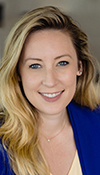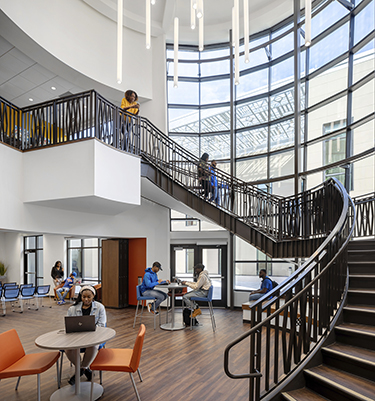|
Subscribe / Renew |
|
|
Contact Us |
|
| ► Subscribe to our Free Weekly Newsletter | |
| home | Welcome, sign in or click here to subscribe. | login |
Architecture & Engineering
| |
 |
April 15, 2021
The evolution of campus, a new normal for higher education
DLR Group

Eckhardt
|
What initially began as a listening exercise to understand the pandemic across the higher education sector has blossomed into a framework for a design practice and, most importantly, a driving force for sweeping change across the industry.
Members of DLR Group’s higher education team are conducting an ongoing national research study, engaging with more than 170 institutions through one-on-one interviews across every aspect of campus. Along the way, we’re gathering input from students, faculty, staff and administrators as we discuss ways in which campuses have responded to the events of the past year and will continue to evolve into the future.
During this research effort, we are exploring approaches taken by many institutions nationwide, including the Pacific Northwest, for rethinking design now, for the future. The adaptation of the built environment is playing a critical role in the future of learning, student success, and access to education. At this pivotal junction, institutions are looking beyond traditional delivery models and the typical classroom, to embrace technology in a way that connects the world in a seamless exchange of knowledge sharing for the next generation of students.
Academics: Institutions are reevaluating student and faculty needs, driven by expectations about the campus experience. Parameters for time, accessibility, and flexibility will collectively reshape the environments for learning and research. Ramifications of the pandemic have taught us that learning has — and will — rapidly expand beyond the traditional classroom.
Planning: Beyond the building, campuses facilitate strong relationships between architecture and sociology. In many cases, a student’s campus experience is the time to build character by learning from a diverse network of peers, exploring new passions and living independently. Planning for a resilient future of the campus experience gives institutions the tools to embrace an ever-changing world.
Work spaces: A remote-renaissance has paved the way for campuses to think critically about the value and purpose of work environments. These may no longer be assigned based on title alone, but instead focus on meaningful, collaborative and social environments where people come together for intentional reasons.
LOCAL PERSPECTIVE
The Northwest is home to some of the finest colleges and universities in the country. During a recent AIA Seattle event, I spoke with three institutions that shared evolving outcomes informing their respective campuses.
Bellevue College in Bellevue already had a strong remote learning system in place, so when the remote transition occurred, it was well received. Faculty perspectives have since evolved to envision using shared campus spaces in addition to traditional academic work spaces.
• Diversity, equity and inclusion work is occurring on campus, and experiences for Bellevue College’s majority commuter populations could be enhanced through a wider variety of indoor and outdoor spaces. The campus nestled in the forest seeks to become “more inclusive, more embracing, more nurturing for everyone who visits.”
• Changing the perspective for reasons to be on-campus allows for increased flexibility for the campus community. The on-campus experience is tailored towards enriching the academic and social hub for the community.
• Repurposing infrastructure to support the community for alternative uses, and as a receiver for new projects and initiatives is driven by the state of Washington in order to serve constituents.
Central Washington University in Ellensburg strives to return to an on-campus experience to support the majority of its students who seek in person engagement in fall 2021. The university is focused on increasing effective utilization of space on campus, as facility design and evolving pedagogy are aligning to ensure flexible models of learning continue into the future.
• An emphasis on health and wellness is a growing trend that has seen a growing need for services on campus. It highlights the critical resources of the campus to support the increase in student needs.
• The university is seeking partnership opportunities to support operational and functional needs of the physical campus, in coordination with the local municipalities. Carbon emission reductions and energy reduction goals are dependent on these relationships.
• All parties are looking forward to the future and managing the learning and social activities on campus to keep the Wildcat Spirit strong.
Washington State University in Pullman has maintained a small degree of research faculty and courses in person to manage critical on-campus activities. According to one university representative, the capacity to change was surprisingly easier during the transition to remote learning and will have longer term opportunities for expanding access for education.
• Social aspects of higher education are more important than ever. WSU has embraced new and exciting ways to engage the campus community through remote activities and will continue to build upon the social aspects of the campus experience.
• As some initiatives have stalled, new relationships have formed. The partnerships with the local health authorities, like on-campus blood drives, have expanded new networks for the university to contribute to. The energy focused on community health is a new frontier and an aspect of the campus experience that WSU is excited about.
• A lot of traditions have been upended and WSU has the capacity to quickly adapt, with the infrastructure support of new and expanding tools to tailor support for achieving the institution’s mission.
These campuses have found creative ways to continue the critical steps of bringing communities together. At the end of the day, it’s not about the trends — it’s about what’s intrinsic in the culture of an institution, and how we as designers can help tell that story through our work.
Jackie Eckhardt leads DLR Group’s higher education practice in the Northwest and contributes as a thought leader to national campus planning projects from the firm’s Seattle office.
Other Stories:
- Seattle’s U District housing boom: is there room for it?
- Sourcing regional materials for higher ed
- New design requires thoughtful programming
- Early-stage design helps Hermanson with UW center
- How to make master plans that work
- The post-pandemic educational learning curve
- Sustainable student housing building design for higher education
- The evolving building delivery models at higher education institutions



